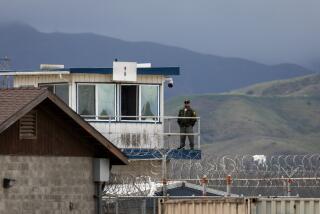What U.S. Congress Should Do to Keep Our Streets Safe : The comprehensive and effective anti-crime act recently passed sends a strong message that violent crime will not be tolerated.
- Share via
The most fundamental right that government owes its citizens is personal safety. This summer, Congress took an important step in protecting that right by passing the toughest and most effective federal anti-crime measure ever.
The Violent Crime Control and Law Enforcement Act will go a long way toward helping the states and local governments make streets and neighborhoods safer, increasing their ability to enforce our laws and to punish those who commit violent crimes. Although law enforcement is and should remain primarily a state and local responsibility, the severity of the crisis warrants federal assistance.
This comprehensive act will help provide:
* One hundred thousand more police officers in our neighborhoods. Grants will help provide 20% more cops patrolling neighborhoods, responding to community concerns and getting criminals off the streets. Putting more police in troubled neighborhoods is the most effective way the federal government can help make neighborhoods crime-free.
* More police officers with better education and training. A new Police Corps program will provide college scholarships for students who agree to serve as law enforcement officers for at least four years. Scholarships will be available to men and women already serving as police officers.
* More federal crime fighters. The Border Patrol will hire 4,000 more agents over the next four years. The bill also provides for hundreds of additional agents at the Federal Bureau of Investigation and the Drug Enforcement Agency.
The law also requires tougher sentences for violent criminals and more prisons to put them in:
* “Three-Strikes-and-You’re-Out” will keep career violent offenders in prison.
The law mandates life imprisonment for anyone convicted of a third violent felony when the last one is a federal offense. Statistics indicate that a very small percentage of criminals account for a large percentage of violent crimes--and that they spend shockingly little time in jail.
* States will receive $9 billion to keep violent criminals behind bars and to repay the costs of incarcerating illegal aliens.
Grants will help states build necessary prisons. A large portion of those funds are for states that impose rigorous standards for jailing violent offenders.
As the result of an amendment I offered to the bill, $1.8 billion of these funds will be used to reimburse states and local governments for the costs of imprisoning criminal illegal aliens. California will receive the largest single payment, meaning a savings to California taxpayers of about$750 million.
* Juveniles will be punished according to the crimes they commit.
For the first time, offenders as young as 13 can be tried as adults for certain violent crimes if the prosecutor and the presiding judge agree. Alternative incarceration approaches for juveniles, such as boot camps to provide discipline and training, are also a part of the new law.
* Drug offenders will receive substance-abuse treatment.
To help reduce the number of people incarcerated for nonviolent crimes, special Drug Court programs will provide rehabilitation and close monitoring of first-time or nonviolent drug offenders. More federal and state inmates will receive intensive treatment during their incarceration.
At least 60% of violent crime is associated with drug use. Addicts commit 15 times as many robberies and 20 times as many burglaries as criminals not on drugs. Approximately 70% of the nation’s 1.4 million prisoners have drug problems, but only 1% of federal inmates and about 15% of state prisoners receive adequate treatment.
Properly run prison-based anti-drug programs have produced good results: The rearrest rate for prisoners who undertake them is about one-third the rate for those who do not. And treatment in prison is a bargain. Housing one inmate one year costs $28,000; adding full drug treatment, about $3,000.
Finally, the new law provides more prevention to stop crime before it happens:
* Assault weapons and gun sales to juveniles are banned. The bill bans 19 semiautomatic weapons--the weapons of choice of drug dealers, gang members and mass murderers. It also prohibits sales of guns to minors and prohibits minors from carrying handguns.
* Young people will be steered away from crime and gang membership. To deter children and youths living in high-crime areas from embarking upon a life of crime, intensive programs are established or expanded to educate youths, find them jobs and provide sports activities and other programs.
* Efforts to stop domestic violence will be expanded. Additional federal resources will be available to combat sexual and domestic violence through education, law enforcement training and a national domestic violence hot line. Gender-based violence will now be a federal civil-rights violation.
Understandably, crime remains the No. 1 concern for most Americans. While local and state governments remain responsible, as they should, for enforcing most of our criminal laws, it is entirely appropriate that the federal government make additional resources available and send a strong message that violent crime will not be tolerated. The $30 billion that Congress has just voted is an appropriate and measured response to the widely held belief that this is a problem that we need to attack with all our resources.
More to Read
Sign up for Essential California
The most important California stories and recommendations in your inbox every morning.
You may occasionally receive promotional content from the Los Angeles Times.













